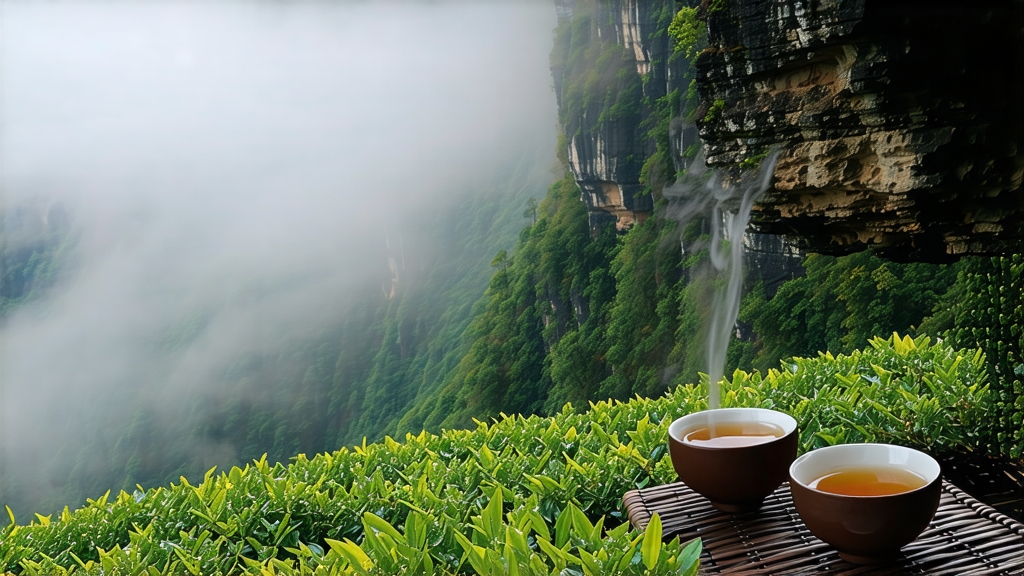
Wuyi Da Hong Pao—literally “Big Red Robe”—is the most storied sub-variety of Chinese oolong, a tea so mythic that emperors once sent guards to protect the six mother bushes clinging to a narrow crevice 600 m above the Nine-Dragon Gorge. For international drinkers who know oolong only as a generic “half-fermented” tea, Da Hong Pao offers a liquid map of China’s cultural landscape: Song-dynasty poetry, Ming-era imperial tribute, Qing smugglers, Republican-era scholars, and 21st-century auction houses where 20 g of vintage leaf has sold for more than 30,000 USD. Yet beyond the headlines, the everyday pleasure of Da Hong Pao is democratic: a single serving can re-steep a dozen times, each infusion revealing a different facet of Wuyi’s mineral terroir.
History: From Imperial Robe to Global Cup
The legend most often repeated in Wuyi’s mountain villages tells of a Ming scholar who, on his way to the capital, fell ill at the Tianxin Yongle Temple. Monks brewed leaves picked from nearby bushes; the scholar revived, passed the imperial exams, and returned in crimson robes to drape the saving bushes in gratitude—hence the name. Whether apocryphal or not, by 1385 the court had designated these bushes as “cha gong,” tribute tea, and Qing records list 1.35 tonnes yearly shipped north via the Grand Canal. When the 19th-century tea clipper trade exploded, Wuyi yancha (“rock tea”) traveled to London where it was marketed as “Bohea” and confused with black Keemun; nevertheless, Victorian tasters praised its “snappy orchid aroma.” After 1949 the mother bushes were nationalized; cuttings were taken in 1985, 1992 and 2006, creating genetically identical “qizhong” (pure breed) gardens lower on the mountain. Today the original six bushes, preserved but no longer harvested, serve as a national monument, while hundreds of tons of “Da Hong Pao” are blended from these offspring or from skillfully roasted Shui Xian or Rou Gui cultivars sold under the same trademark.
Micro-Terroir: Why “Rock Rhyme” Matters
UNESCO lists the 60 km² Wuyi range as a World Heritage biosphere because its Danxia cliffs create a unique heat-radiating microclimate. Day-night temperature swings of 15 °C stress the leaves, condensing sugars and amino acids; quartz-rich soils impart a metallic finish locals call “yan yun”—rock rhyme. Within the core scenic zone only three valleys—Niulan keng, Huiyuan keng, and Daoshui keng—are deemed “zhengyan” (true cliff). Leaves grown here absorb mist until noon, then bake in reflected cliff heat, producing the flinty, cacao-bean note that separates elite Da Hong Pao from lower-elevation “banyan” or flatland “zhou cha.” Because true-cliff leaf is scarce, most exporters use a pyramid of provenance: qizhong (pure genetic line) plus 30–70 % high-grade Shui Xian for body, with perhaps 5 % Rou Gui for cinnamon top notes. The result still carries legal right to the name “Da Hong Pao,” but connoisseurs label bottles with harvest date, valley, and percentage of qizhong content.
Craft: The 13-Step Choreography of Rock Oolong
Unlike green tea that aims for freshness, Da Hong Pao is valued for the transformation imposed by fire. The craft cycle begins at 4 a.m. when pickers pluck the standard “zhong kai mian” (medium opening) consisting of bud plus three or four mature leaves; the extra cellulose survives the roasting to come. After solar withering for 30–40 min, the leaves are shaken in 1.2 m diameter bamboo drums every hour for 6–8 h to bruise edges and initiate oxidation at 25 °C. When the leaf rim turns 30 % red and the grassy note fades to peach, the tea is quickly pan-fired at 220 °C for 7 min to kill enzymes, then rolled into the distinctive Wuyi strip shape. The critical distinction is the charcoal roasting: using only local hardwoods (primarily Chinese oak), craftsmen maintain a